To some Napoleon Bonaparte was one of the greatest military geniuses of all time. He used the French Army (and those of allies) to spread the French revolutionary ideals of liberty, equality, and fraternity across Europe. His vision was of a united Europe, under the hegemony of France. To others he was a bloodthirsty tyrant, mad with conquest, who simply wanted to rule the world. From the late 1790s to 1815, with only brief periods of peace, Europe, the Indian subcontinent, and the waters of the Caribbean were theaters of war between his French Empire and the coalitions formed to defeat it, financially and militarily backed by Great Britain.
The combined wars against Napoleon were known in European history as the Great War until another usurped that title a century later. During those conflicts, innovations in warfare occurred within the contending armies, navies, and in the governments which sent them to the field or to sea. Some were immediately adopted, others were set aside to be further developed until they became assets in later wars. Here are 10 innovations in warfare from the wars of Napoleon at the beginning of the 19th century.
10. The submarine Nautilus was offered to the French Navy
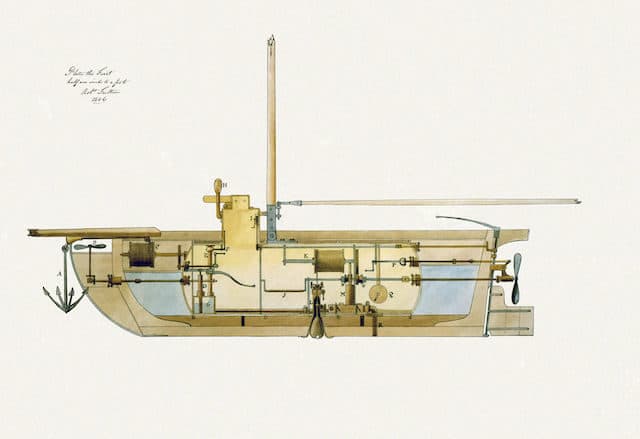
American Robert Fulton went to France in 1793, where he designed and built the first practical submarine, driven by a hand cranked propeller. Fulton created movable diving planes to control depth and dive angle, submerging his submarine using a hollow keel which served as a ballast tank. The hull was built of copper sheets. In his 1801 experiments he succeeded in diving to a depth of 25 feet, and maneuvering the vessel to place explosives – he called them carcasses – under the hull of a disused ship. A personal interview with Napoleon earlier failed to generate any interest in the vessel, which changed when the First Consul learned of the success witnessed by representatives of his Minister of Marine.
By the time Napoleon asked for another demonstration of the vessel, Fulton had already disassembled it, with plans for an improved version underway. Napoleon decided that the American had cheated his Minister of Marine out of the funds provided for the earlier experiments, and Fulton left France for England. There he found little interest in the vessel from the British Admiralty, though they did award him some funds to keep him from returning to France. By 1806 the Royal Navy controlled the waterways around Europe, and with little enthusiasm for the American’s ideas in England he returned to the United States.
9. The increase of regiments armed with rifles
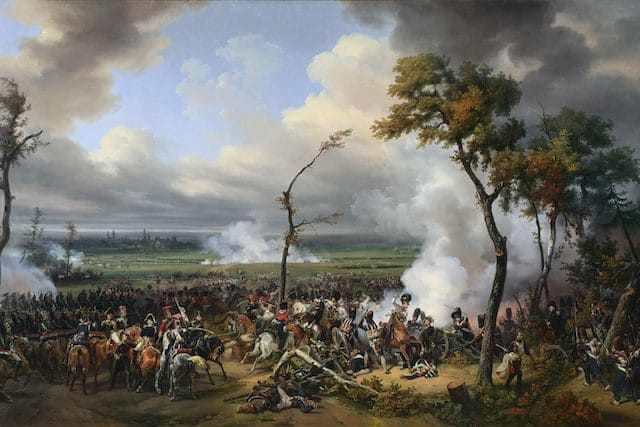
The primary weapon of French infantry and most cavalry was the Charleville musket, a smoothbore muzzle loading weapon which was also used by many of the armies they fought (in variations). But rifles were deployed by several armies as well. Rifles were slower to load, but their increased range and accuracy made them excellent weapons for light troops used as skirmishers. Jagers from the German provinces often carried rifles, as did the British 95th Regiment, which also replaced the famed red coat of the British Army with one of green. They were armed with a British made weapon, the Baker Rifle.
The 95th served with distinction in several theaters from their founding in 1800 as an Experimental Corps, including as marksmen aboard ships of the British fleet at the Battle of Copenhagen. They gained fame as a regiment during the Peninsular War, under Sir John Moore and later Arthur Wellesley, and served with the latter at the Battle of Waterloo in 1815. During the Peninsular War they served as skirmishers and as regular line troops, using their accurate weapons to destroy the command and control of their enemies by targeting officers, and drummers, who sent the signals to the troops. They also effectively targeted enemy artillery crews using their longer range.
8. Steam powered warships emerged in experimental form
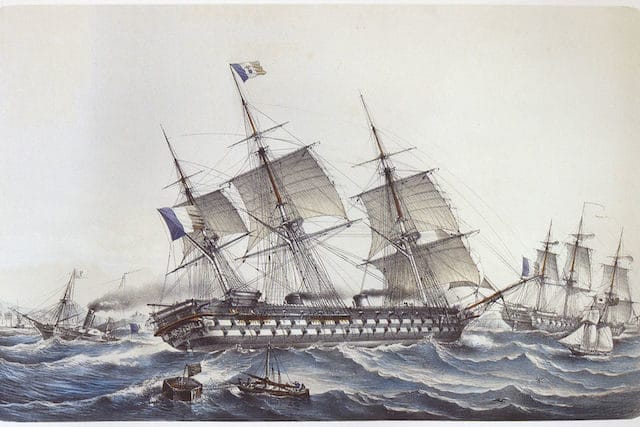
During the period of the Napoleonic Wars in Europe the United States was officially neutral, though it was drawn into an early naval conflict with France (the Quasi-War, 1798-1800) and later with England in the War of 1812. The issues which caused the latter war arose directly from the Napoleonic wars, though the United States did not ally itself with France, nor did British allies against Napoleon join in the war with the Americans. It was, to the British at the time and to history, a sideshow. But it was the war which saw the birth of the steam powered warship, another innovation by Robert Fulton.
Authorized by an Act of Congress in March, 1814, Fulton built a steam powered ship which he named Demologos, though the ship was never formally christened. Fulton died in February, 1815, after which the ship was named Fulton in his honor. It was launched in October, 1815, and began sea trials that fall, which continued the following spring. Though it never served in battle, it was nonetheless the first steam powered warship ever built, meant as a defense against the British Navy in American waters. Russia, Britain, and France did not begin experimentation with steam warships for a decade after the end of the Napoleonic wars.
7. Increased use of skirmishers and patrols between combatant lines
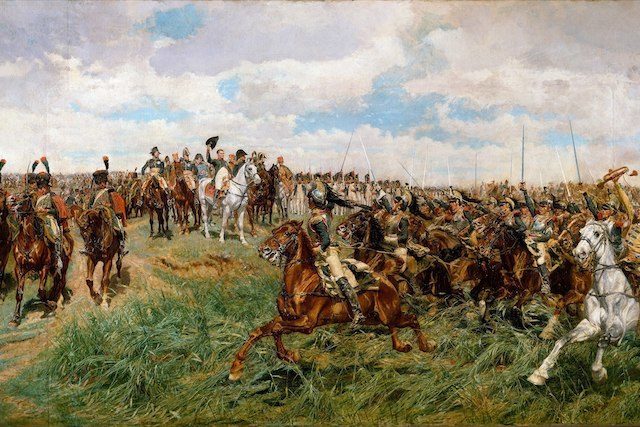
One of the changes of tactics which Napoleon’s French armies brought to the battlefield was the increased use of light infantry as skirmishers, engaging enemy units to the extent that they were held in place. Skirmishers, and the use of patrols to pinpoint the presence of enemy units, were necessary to support his most important battlefield attribute, speed. Napoleon stressed speed in the design of his army, in the manner in which it was fed, and in its method of approaching the enemy. Napoleon was a trained artillerist, and his study of the use of cannon on the field of battle also reflected his need for speed. French artillery during the Napoleonic Wars was the lightest in the world, giving it superior mobility.
Napoleon ordered the creation of units of voltigeurs, French for vaulters, in 1804. These men, formed from within the ranks of existing line units of the French army, were those considered to be the best marksmen. The voltigeurs received what later would be called advanced infantry training, including the best use of the ground and other cover, and additional marksmanship training. Their effectiveness in battle was noted by their enemies. They were for a time also trained to ride, moving with cavalry units, an effective means of harassing a retreating enemy, but a system which proved difficult to follow when cavalry was needed elsewhere during battle.
6. Feeding the troops and the armies’ animals
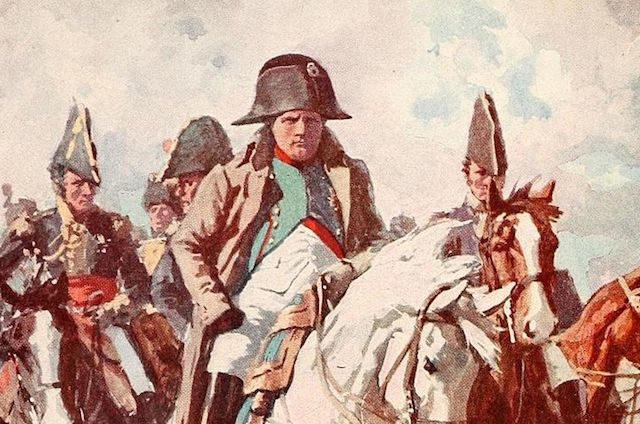
Napoleon recognized that long supply trains slowed down his armies, and any loss of speed was aberrant to him. They also increased the number of horses and draft animals required of the army. Animals needed to be fed, as did the troops. Napoleon’s preferred means of feeding his armies was off the land, either through outright foraging or through purchasing supplies from friendly nations as the army marched through. Napoleon also established depots from which supplies for the armies were dispatched, chiefly hard bread, but for the most part the troops were left to their own devices.
The French military did seek ways to improve both the quantity and quality of the food available to their troops. In 1800, then First Consul Napoleon Bonaparte offered an award of 12,000 francs for a method of preserving food other than salting and smoking. The prize inspired French chef Nicolas Appert to devise a means of bottling food now known as canning. Though Appert demonstrated his invention in 1806 he did not receive the prize until 1810, and then only on the condition that he share the process openly. Unfortunately, there was no improved means of shipping to move the canned food to the troops, and the Napoleonic Wars ended before canned foods became a major part of soldiers’ rations.
5. An organized ambulance service implemented by the French
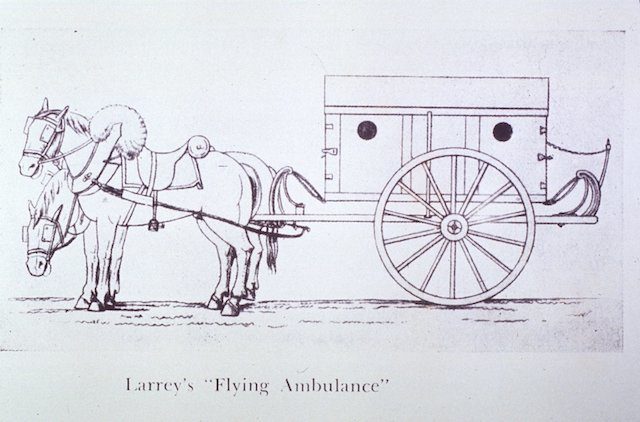
When French surgeon Dominique Jean Larrey saw the speed with which Napoleon’s artillery was drawn, the result of using lighter carriages and the extensive training of the crews which manned them, he had an inspiration. Larrey believed that fast attention to the wounded saved lives. He designed what he called ambulance volantes – flying ambulances – to transport wounded to treatment centers behind the lines. He also developed the training for their drivers, litter bearers, and the medical corpsmen who used them. Larrey also established the use of triage when evaluating the wounded, with care dispensed based on the urgency of individual cases.
Larrey proposed, and it was established, that battlefield wounded be treated regardless of whether they were hostile or friendly, an act which later saved his life. After the Battle of Dresden he personally saved the life of a wounded Prussian officer taken prisoner by the French. He was the son of Prussian Field Marshal Gebhard von Blucher. When Larrey was taken prisoner by the Prussians in the aftermath of Waterloo he was threatened with execution before a Prussian surgeon recognized him and identified him to von Blucher, who ordered that he be spared and treated him as a guest at his table before releasing him.
4. Nationwide semaphore telegraphs

In 1792 Frenchman Claude Chappe and his brothers developed a system of towers, from which semaphore messages could be sent, increasing the speed of communications over distances. During the early French Revolutionary Wars, lines were built across France and the territories occupied by French armies, or aligned with the French. By the time of Chappe’s death in 1805, messages from Paris could reach the coast along the British Channel in a few hours, rather than the days previously required. Napoleon had the system expanded across France and used it to monitor his armies and the changing European situation.
Napoleon as Emperor in Paris could communicate as head of the army with generals in the field, closer to real time than any preceding military commander. To prevent spies from infiltrating the system, the operators of the towers which passed messages along were not trained in the code they transmitted. They simply copied what they saw from another tower. When Napoleon’s son was born on March 20, 1811, word that the Emperor had an heir was received in Strasbourg in one hour. In 1805 Napoleon extended the semaphore line into Milan from the Paris – Lyon line specifically to enhance communications to Italy as part of his preparations for renewed warfare there against the Austrians.
3. Vastly more powerful artillery
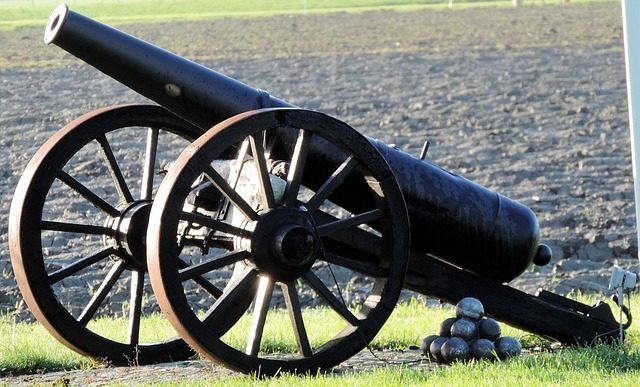
Napoleon was trained as an artillery officer, and his use of it as a young captain during the siege of Toulon launched him on his career with what was at the time the Republican Army during the Revolutionary Wars. His understanding of its firepower he coupled with his drive for speed when moving armies, both on the march and on the battlefield. One of his first acts as First Consul was to establish an artillery staff which he retained under his personal control. The staff established and supervised artillery schools for the army. It also supervised the manufacture of cannon and ammunition.
The ratio of cannon to men in the French Army increased each year of the Empire until 1814. Guns were distributed throughout the French Army – itself divided into self-supporting corps – with guns traveling with infantry and cavalry units, as well as artillery battalions. Napoleon’s insistence on fast-moving horse cavalry on the battlefield enabled him to bring up heavier firepower at critical moments of a battle. Napoleon’s reputation as an artillerist, of which he was quite proud, also eased recruiting for the artillery. In no other army of the day was the artillery branch so well regarded, and favored by the leader of the army.
2. Increased mobility and maneuver of armies
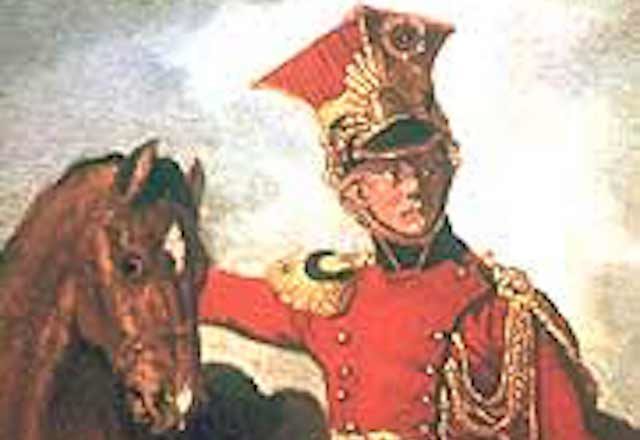
Napoleon divided his Grand Army into what were in effect several smaller, self-contained armies, which were called corps’ of the army. Each of these smaller armies were capable of defending themselves against larger armies while additional corps came to their aid, or of rapidly deploying to aid one of their fellow corps. On the march they usually took different routes towards their common objective, allowing them to better forage off the land. This allowed them to carry fewer supplies and thus move more rapidly. Each was commanded by either a Marshal of France or a Major General.
The size of each corps was flexible, with troops added when necessary in accordance with the importance of its assignment, with divisions, or smaller units, transferred between them. The use of the corps allowed Napoleon to rapidly move large concentrations of troops while masking to some extent his intentions. The senior regiment of Napoleon’s army were the Grenadiers of the Old Guard, infantry veterans of previous campaigns. They called themselves the grognards, a nickname which was given them by the Emperor in 1807. Grognards is French for grumblers.
1. Military use of canals and inland waterways

The Napoleonic Wars coincided with widespread development of canals. Canals were seen as a means of rapidly moving troops and supplies in times of national peril. In England, the Royal Military Canal was built between Seabrooke and Cliff End specifically as a defense measure against the possibility of French invasion. Begun in 1804, when the possibility of invasion was very real, it was completed in 1809, when the chances of a French invasion were remote.
The British Navy dominated the seas by 1806, and French shipment of goods and troops on waterways were limited to coastal vessels and barges on the coast, and similar means on inland rivers. Napoleon planned a series of canals to move goods and troops throughout his empire, and began construction of the Damme Canal to connect Bruges to the Scheldt estuary in 1810. Spanish prisoners of war and convicts sentenced to the galleys were used for labor. When Napoleon abdicated in 1814 the project was abandoned and not completed for another four decades. By then another Napoleon, nephew of the first, was on the throne of France.